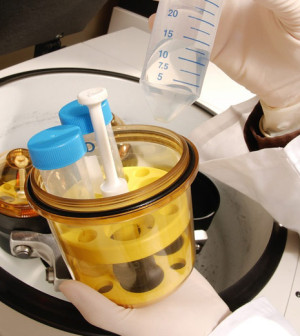- Skip Storing This Everyday Product in the Fridge Door
- Green Tea + B3 Pairing May Boost Brain Health
- Navigating Your Midlife Crisis: Embracing New Possibilities
- City Raccoons Showing Signs of Domestication
- Mapping the Exposome: Science Broadens Focus to Environmental Disease Triggers
- One Week Less on Social Media Linked to Better Mental Health
- Your Brain Changes in Stages as You Age, Study Finds
- Some Suicide Victims Show No Typical Warning Signs, Study Finds
- ByHeart Formula Faces Lawsuits After Babies Sickened With Botulism
- Switch to Vegan Diet Could Cut Your Greenhouse Gas Emissions in Half
Skin Cells Used to Create Heart Valve for Growing Kids


While artificial heart valves have long been available to adults, making permanent valves for children has been challenging because kids’ bodies keep growing.
But researchers say they’ve found a way around that, using a child’s skin cells to make a new pulmonary valve for the youngster’s heart to replace a faulty one.
Using a child’s own skin cells to create the new valve reduces the risk of rejection, the researchers explained, and means the valve can grow with the patient — reducing the need for future valve replacements.
The findings appear in the September issue of the Annals of Thoracic Surgery.
“Current valve replacements cannot grow with patients as they age, but the use of a patient-specific pulmonary valve would introduce a ‘living’ valvular construct that should grow with the patient,” lead author David Simpson, of the University of Maryland School of Medicine, said in a journal news release.
“Our study is particularly important for pediatric patients who often require repeated operations for pulmonary valve replacements,” he added.
In the study, Simpson’s team developed a method to turn skin cells from a biopsy into cells that help create a tissue-engineered pulmonary valve.
The pulmonary valve connects the heart to the pulmonary artery, which carries blood from the heart to the lungs.
“We created a pulmonary valve that is unique to the individual patient and contains living cells from that patient,” study senior co-author Dr. Sunjay Kaushal said in the news release. “That valve is less likely to be destroyed by the patient’s immune system, thus improving the outcome and hopefully increasing the quality of life for our patient.”
Some day, “it may be possible to generate this pulmonary valve by using a blood sample instead of a skin biopsy,” Kaushal added.
The next step in this research will be to implant the new valves in patients to assess how well they work and how long they last, the study authors said.
More information
The U.S. National Library of Medicine has more about heart valve problems.
Source: HealthDay
Copyright © 2025 HealthDay. All rights reserved.










